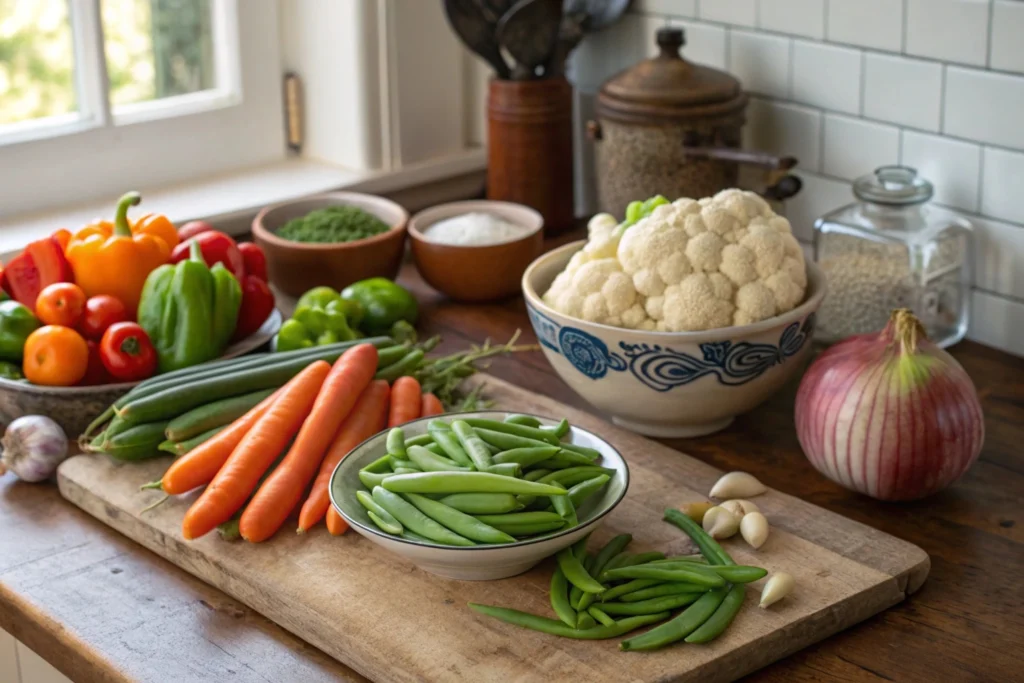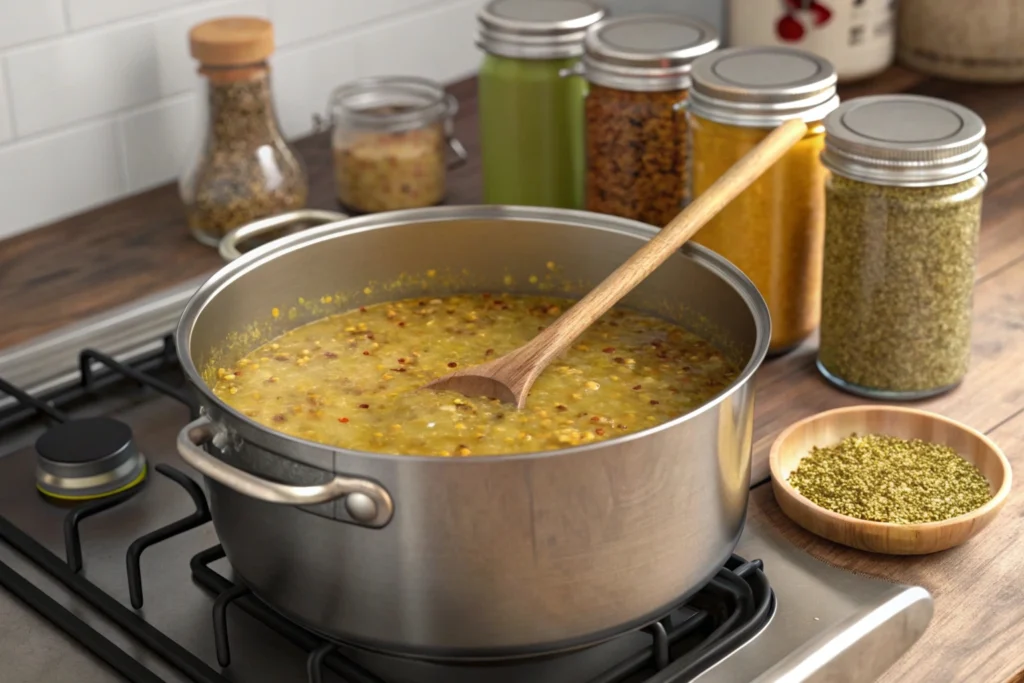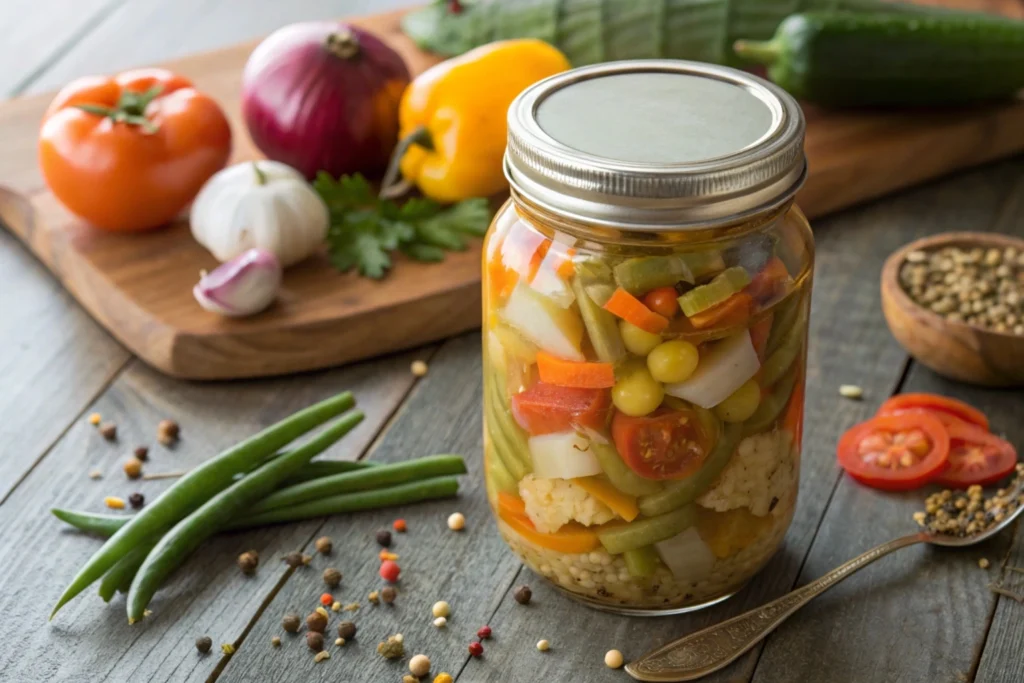Amish Chow Chow is a charmingly unique and vibrant pickled relish that holds a special place in the culinary traditions of Amish and Pennsylvania Dutch communities. Made with a medley of vegetables and a perfectly balanced sweet-and-sour brine, this dish beautifully showcases the ingenuity and resourcefulness of using seasonal produce. In this article, we will, therefore, uncover the origins, ingredients, preparation methods, and various uses of this delightful relish. So, let’s dive in!
Understanding Amish Chow Chow
What is Amish Chow Chow?
Amish Chow Chow is a tangy, sweet, and colorful pickled relish crafted from a mix of fresh vegetables. Typically made at the end of the growing season, it was born out of necessity, ensuring no produce went to waste. As a result, cooks preserve the vegetables in a flavorful brine, making them shelf-stable and enjoyable year-round.
Though it shares similarities with Southern Chow Chow, the Amish version often has a sweeter flavor profile and incorporates a unique variety of vegetables.
Historical Background of Amish Chow Chow
The roots of Amish Chow Chow stretch back to the traditions of the Amish and Pennsylvania Dutch, who emphasized simplicity, frugality, and self-reliance in their cooking. Chow Chow emerged as a practical solution for preserving surplus vegetables before the winter months.
Interestingly, Chinese immigrants may have influenced the term “Chow Chow” with their pickled dishes brought to America, which evolved over time into its own distinct regional recipe.
- Origins of Chow Chow: A blend of influences from diverse cultures, adapted into Amish cooking.
- Evolution in Amish Cuisine: Transitioned from a preservation technique to a beloved culinary staple served at gatherings and holidays.
Cultural Significance
Amish Chow Chow is more than a relish; it’s a reflection of community values and shared meals. The dish often graces tables during family dinners and church events, symbolizing togetherness and gratitude for the harvest.
Additionally, families have passed down the tradition of making and canning chow chow through generations, preserving both vegetables and a way of life that values sustainability and resourcefulness.
- Role in Amish Traditions: Served as a humble reminder of the harvest’s bounty.
- Preservation Practices: A testament to amish ingenuity in extending the shelf life of seasonal vegetables.
Ingredients of Amish Chow Chow
Core Vegetables Used

The foundation of Amish Chow Chow lies in its vibrant medley of core vegetables, each adding its distinct flavor and texture. Cooks choose these vegetables not only for their taste but also for their ability to absorb the tangy, sweet brine.
- Green Beans: A popular addition, green beans bring a crisp texture that pairs beautifully with the pickling process.
- Lima Beans: Often overlooked, lima beans are a must in Chow Chow, offering a creamy bite and hearty feel.
- Sweet Peppers: Their mild sweetness adds balance to the dish, and their vivid colors make the relish visually appealing.
- Carrots: With their natural sweetness and firm texture, carrots are a staple ingredient in most recipes.
- Cauliflower: Breaking into tender florets, cauliflower absorbs the brine well, adding a slightly nutty undertone.
This combination of vegetables creates a harmonious blend of crunch, sweetness, and earthiness, making the dish delightful to both the eyes and the palate.
Additional Vegetables
In addition to the core vegetables, many variations of Amish Chow Chow incorporate additional vegetables to enhance flavor complexity and color.
- Corn: Sweet kernels of corn contribute pops of sweetness and a pleasant burst of texture.
- Onions: Sliced thin, onions impart a subtle sharpness that contrasts the sweetness of the brine.
- Green Tomatoes: These firm, slightly tart tomatoes lend a unique flavor, complementing the pickled medley.
- Cabbage: Shredded cabbage introduces a tender, slightly crunchy element that balances out the other vegetables.
These add-ins allow for creative adaptations, making Amish Chow Chow versatile while staying true to its roots.
Pickling Brine Components
The soul of Amish Chow Chow lies in its tangy-sweet pickling brine. In fact, this brine is the secret not only to preserving the vegetables but also to infusing them with robust flavor.
- Vinegar: A key ingredient, vinegar gives the brine its tanginess, preserving the vegetables and creating that signature zing.
- Sugar: Balances out the acidity of the vinegar, delivering the signature sweetness of Amish Chow Chow.
- Mustard Seeds: These tiny seeds add a subtle heat and earthy undertone to the dish.
- Celery Seeds: Known for their slightly bitter, aromatic flavor, celery seeds elevate the overall seasoning.
- Turmeric: Not just for color, turmeric brings a warm, peppery flavor that enhances the relish’s complexity.
This perfectly calibrated blend of spices and liquids, therefore, transforms simple vegetables into a symphony of flavors, ensuring that every bite is irresistibly bold and balanced.
Preparation Methods
Vegetable Preparation
The process begins with carefully preparing the vegetables to ensure they retain their freshness and flavor throughout.
- Cleaning and Chopping: Vegetables are thoroughly washed to remove any dirt or residue. They’re then chopped into uniform pieces to ensure even pickling. Precision is key, as the size impacts texture and brine absorption.
- Blanching Techniques: Some vegetables, like green beans and cauliflower, are blanched briefly to soften their texture. This step helps lock in vibrant colors and ensures they remain slightly crisp after pickling.
Proper preparation sets the stage for a perfectly balanced relish that’s both flavorful and visually stunning.
Brine Preparation

Crafting the perfect brine is an art form that requires balancing sweet, sour, and spicy elements.
- Balancing Sweet and Sour Flavors: The right ratio of vinegar to sugar, therefore, ensures the brine has a harmonious tangy-sweet flavor. Additionally, adjustments can be made based on personal preferences, with some opting for a slightly sharper or sweeter profile.
- Spice Mixture: The addition of mustard seeds, celery seeds, and turmeric is carefully measured to avoid overpowering the vegetables. As a result, these spices enhance the flavor without masking the natural taste of the ingredients.
A well-prepared brine is what transforms ordinary vegetables into a bold, zesty delight.
Combining Vegetables and Brine
The final step is where the magic happens—bringing together the prepared vegetables and flavorful brine.
- Marination Process: Vegetables are submerged in the brine, ensuring each piece is fully coated. Consequently, this step is crucial for infusing the flavors deeply into the vegetables.
- Ensuring Flavor Absorption: The mixture is allowed to marinate for at least 24 hours, though longer periods result in richer, more robust flavors. Patience pays off here, as the flavors meld beautifully over time.
This stage highlights the importance of attention to detail, ensuring every jar of Amish Chow Chow is a culinary masterpiece.
Canning and Preservation
Traditional Canning Methods
Preserving Amish Chow Chow is a critical step that ensures its longevity and allows you to enjoy it throughout the year. Furthermore, the traditional methods used in Amish communities reflect their commitment to both quality and safety.
- Sterilizing Jars:
Before canning, the jars and lids must be sterilized to prevent contamination. This process involves washing them thoroughly and, subsequently, placing them in boiling water for 10 minutes. Sterilization ensures the jars are free from bacteria, mold, or yeast, which could spoil the Chow Chow.
Pro Tip: Always handle sterilized jars with clean tongs to avoid recontamination. - Hot Water Bath Canning:
This method involves submerging the filled jars into a large pot of boiling water for a specified amount of time, typically 10–20 minutes, depending on the jar size. The heat creates a vacuum seal, ensuring the Chow Chow remains shelf-stable and safe to eat.
Why it Works: The vacuum seal prevents air from entering the jars, effectively halting the growth of microorganisms that cause spoilage.
Traditional canning preserves the vibrant flavors of the relish while maintaining its delightful texture.
Storage Guidelines
Once canned, proper storage practices are essential to maximize the shelf life and retain the quality.
- Shelf Life:
When stored correctly, Amish Chow Chow can last for up to one year without losing its flavor or texture. However, for the best taste, it’s recommended to consume it within the first six months. - Optimal Storage Conditions:
Store the jars in a cool, dark place, such as a pantry or cellar, to prevent exposure to sunlight and temperature fluctuations. Always ensure the lids are tightly sealed and avoid placing jars near heat sources.
Helpful Hint: Label jars with the date of canning to keep track of freshness.
Proper canning and storage not only preserve the relish but also honor the time and effort invested in its creation.
Variations of Amish Chow Chow
Regional Differences
Amish Chow Chow has inspired variations across different regions, each adapting the dish to local tastes and available produce.
- Southern Chow Chow Ingredients:
Southern Chow Chow often leans toward spicier and tangier profiles compared to its Amish counterpart. Ingredients like green tomatoes, cabbage, and jalapeños are common in Southern recipes, providing a bold kick. This version also uses less sugar, making it more savory. - Pennsylvania Dutch Variations:
The Pennsylvania Dutch version stays true to the sweeter, tangier flavors synonymous with Amish Chow Chow. It typically includes ingredients like green beans, lima beans, and corn, with a generous amount of sugar in the brine. These variations reflect the agricultural staples of the region and a preference for milder flavors.
Exploring regional differences highlights the diversity and adaptability of this cherished dish.
Modern Twists
As with any traditional recipe, Amish Chow Chow has evolved to include contemporary elements that cater to changing palates and culinary trends.
- Incorporating Uncommon Vegetables:
Many modern recipes experiment with vegetables like zucchini, beets, or even asparagus to add a unique twist. These additions bring unexpected flavors and textures, keeping the dish exciting for both traditionalists and adventurous food lovers. - Adjusting Sweetness and Spiciness Levels:
Customizing the balance of sweetness and spice allows home cooks to tailor Chow Chow to their personal preferences. Adding more mustard seeds or crushed red pepper, for instance, can enhance the heat, while reducing sugar results in a sharper, tangier brine.
Modern adaptations ensure that Amish Chow Chow remains a dynamic and versatile addition to any table, bridging the gap between tradition and innovation.
Serving Suggestions
As a Condiment
Amish Chow Chow’s sweet and tangy flavors make it an incredibly versatile condiment, elevating various dishes with its vibrant taste.
- Pairing with Meats:
This relish shines as a complement to roasted or grilled meats. Serve it alongside ham, pulled pork, or roasted chicken to add a refreshing tang. Its acidity cuts through the richness of fatty meats, creating a balanced bite.
Pro Tip: Use it as a topping for hot dogs or sausages for an exciting twist on a classic favorite. - Enhancing Sandwiches:
Amish Chow Chow brings sandwiches to life by adding a burst of flavor and crunch. Whether layered on a turkey sandwich, paired with cheese in a grilled panini, or piled onto a veggie wrap, it provides an irresistible zing.
Quick Tip: Add a spoonful to egg salad or tuna salad sandwiches for a delightful variation.
Chow Chow as a condiment transforms everyday meals into something extraordinary.
As a Side Dish
Beyond being a condiment, Amish Chow Chow also holds its own as a versatile side dish that pairs well with various meals.
- Accompanying Main Courses:
It’s commonly served as a side with hearty dishes like pot roast, meatloaf, or fried chicken. The relish’s tangy-sweet profile balances out the heavier flavors of these entrees, adding complexity to the plate. - Inclusion in Picnic Menus:
A perfect addition to any picnic or barbecue, Amish Chow Chow complements potato salads, coleslaw, and baked beans. Its bright, pickled flavors provide a welcome contrast to the creamy or smoky elements of picnic staples.
As a side dish, Amish Chow Chow enhances both formal dinners and casual gatherings, proving its versatility time and again.
Health Benefits
Nutritional Value of Ingredients
Amish Chow Chow isn’t just delicious—it’s packed with essential nutrients from its wide variety of vegetables.
- Vitamins and Minerals:
The core and additional vegetables in Chow Chow are excellent sources of vitamins such as A, C, and K. Green beans and lima beans, for instance, are rich in folate, while carrots provide beta-carotene, essential for healthy skin and vision.
Did You Know? Cauliflower is a powerhouse of vitamin C, boosting immunity and overall health. - Dietary Fiber Content:
High in fiber, Amish Chow Chow supports digestive health and helps maintain healthy blood sugar levels. Ingredients like cabbage, onions, and green tomatoes contribute to its fiber-rich profile, keeping you fuller for longer.
This relish offers a tasty way to incorporate more nutrients into your diet.
Benefits of Fermented Foods
The pickling process of Amish Chow Chow brings additional health benefits, especially when prepared traditionally with fermentation.
- Probiotic Properties:
While not all pickling involves fermentation, traditionally fermented Chow Chow contains probiotics that promote gut health. These beneficial bacteria aid in digestion and help maintain a healthy balance in the gut microbiome. - Aiding Digestion:
The acidic brine can stimulate digestion, making Amish Chow Chow an excellent accompaniment to rich, fatty foods. It acts as a natural palate cleanser, making meals more enjoyable and easier on the stomach.
By combining flavor and health benefits, Amish Chow Chow earns its place as a wholesome addition to your culinary repertoire.
Frequently Asked Questions
What vegetables are commonly used in Amish Chow Chow?
Amish Chow Chow is made with a delightful variety of vegetables, offering both taste and texture. Common choices include green beans, lima beans, sweet peppers, carrots, and cauliflower. These vegetables form the core of traditional recipes, delivering a blend of crunch and sweetness.
Additionally, other vegetables like corn, onions, green tomatoes, and cabbage are often included to add more complexity to the flavor profile. Each ingredient is carefully selected not only for its taste but also for how well it absorbs the tangy-sweet brine.
The beauty of Amish Chow Chow lies in its versatility; it can be adapted to include any fresh vegetables available at the end of the growing season.
How long does Amish Chow Chow last after canning?
Properly canned Amish Chow Chow has an impressive shelf life, typically lasting up to 12 months. This longevity is due to the vacuum seal created during the canning process, which prevents spoilage by keeping out air and bacteria.
For optimal flavor, it’s best to consume the relish within the first six months. Store it in a cool, dark place such as a pantry or cellar to maintain its quality. Once opened, the jar should be refrigerated and consumed within 1–2 weeks for the freshest taste.
Ensuring proper canning and storage practices can help extend the shelf life and preserve the vibrant flavors of your Chow Chow.
Can I adjust the sweetness or spiciness of the recipe?
Absolutely! One of the joys of making Amish Chow Chow is its adaptability. You can tweak the balance of sweetness and spiciness to suit your taste preferences.
- To adjust sweetness, simply increase or reduce the amount of sugar in the brine.
- For more spiciness, consider adding extra mustard seeds, crushed red pepper, or even jalapeños.
By experimenting with the brine ingredients, you can create a version that reflects your personal flavor preferences while staying true to its essence.
Is Amish Chow Chow similar to Southern Chow Chow?
While Amish Chow Chow and Southern Chow Chow share similarities as pickled relishes, they differ in flavor profiles and ingredients.
Amish Chow Chow typically features a sweeter brine and a more diverse mix of vegetables, such as green beans, lima beans, and cauliflower. It emphasizes a tangy-sweet balance that is signature to Pennsylvania Dutch cuisine.
Southern Chow Chow, on the other hand, leans more toward a spicy and tangy profile. Ingredients like green tomatoes, cabbage, and jalapeños dominate Southern recipes, giving it a bold kick. Both versions are delicious, but their distinct flavors reflect their regional origins.
What dishes pair well with Amish Chow Chow?
Amish Chow Chow is incredibly versatile and pairs beautifully with a wide range of dishes.
- As a condiment, it enhances grilled meats like pork, chicken, or sausages, adding a refreshing tang.
- Use it to top sandwiches or burgers for an extra layer of flavor and crunch.
- As a side dish, it complements hearty entrees like meatloaf, roasted vegetables, or fried chicken.
- At picnics, it’s a perfect addition to potato salad, baked beans, or coleslaw.
Its tangy, sweet, and slightly sour notes make it a delightful pairing with both rich and light meals, offering endless culinary possibilities.
Are there any health benefits to eating Amish Chow Chow?
Yes! It offers several health benefits thanks to its nutrient-rich ingredients and pickling process.
- The vegetables in Chow Chow are packed with vitamins, minerals, and fiber, supporting overall health and digestion. For instance, carrots are rich in vitamin A, while green beans and cauliflower provide essential nutrients like vitamin C and potassium.
- When traditionally fermented, the relish may contain probiotics that promote gut health, aid in digestion, and enhance immunity.
- The vinegar used in the brine is known to aid digestion and regulate blood sugar levels, making Amish Chow Chow a healthy addition to your meals.
With its combination of flavor and nutrition, Amish Chow Chow is as good for your health as it is for your taste buds.
Conclusion
Amish Chow Chow is more than just a pickled relish—it’s a celebration of resourcefulness, tradition, and vibrant flavors. This cherished dish, rooted in Amish and Pennsylvania Dutch culinary heritage, exemplifies how simple ingredients can be transformed into something truly extraordinary. From its diverse mix of vegetables to its tangy-sweet brine, every jar of Amish Chow Chow tells a story of preservation and creativity.
Whether enjoyed as a condiment, side dish, or even a healthy snack, Amish Chow Chow brings a burst of flavor to every meal. Its adaptability to different tastes and its health benefits make it a beloved addition to kitchens everywhere. By exploring its ingredients, preparation methods, and variations, you can honor this tradition while making it your own.
So, why not try your hand at making Amish Chow Chow and bring a taste of this timeless relish to your table? You’ll not only savor its unique flavor but also connect with a culinary tradition that has stood the test of time.

